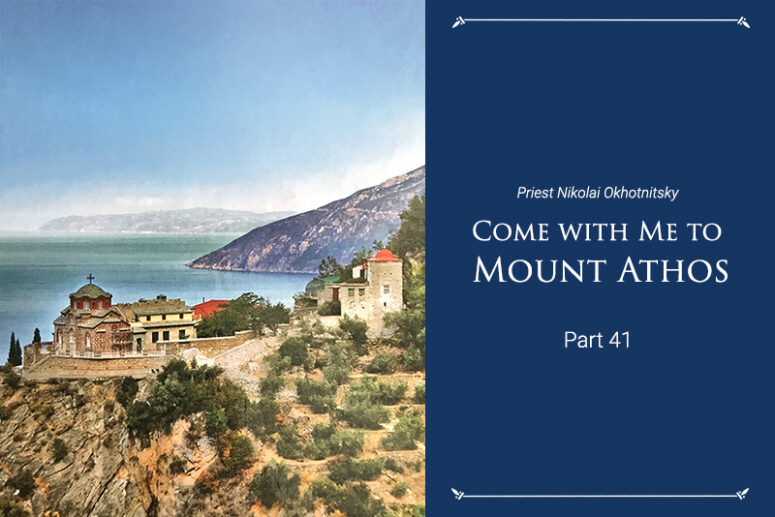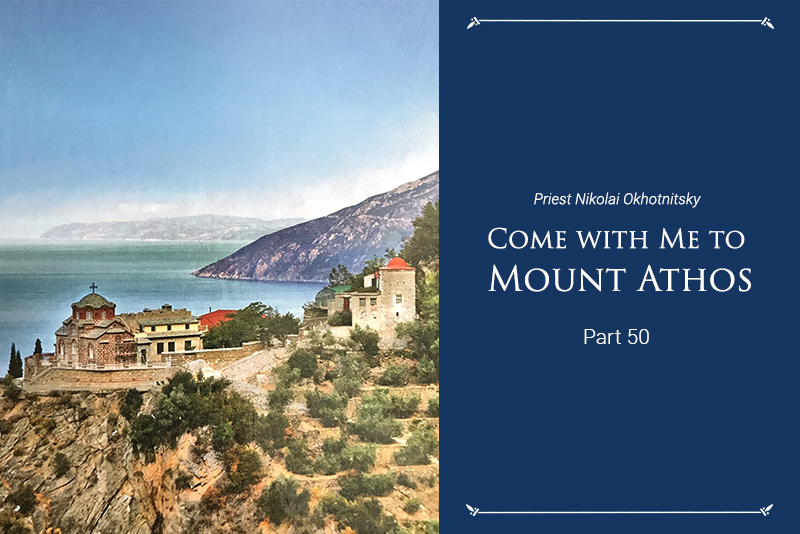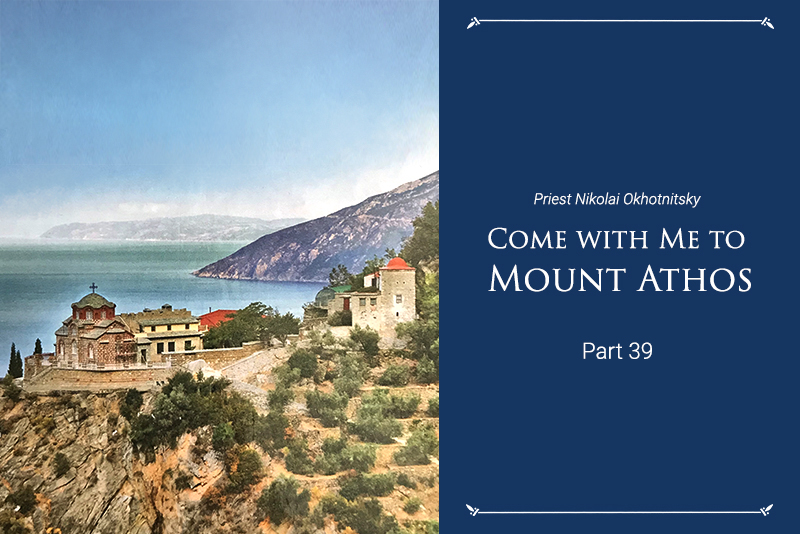
Vespers And Evening Meal
Our windows were located almost directly above the monastery’s semantron. Everyone jumped up and dressed quickly, like soldiers hearing the alert signal. I was “back in black”. At the end of the corridor, not far from our room, there was a fire staircase. We used it to go down to the monastery courtyard. We still had time to walk around it unnoticed before people started gathering for the service. We took some pictures behind the altar, against the marble crosses and huge vases with flowers, on the steps of the catholicon and in the space between the columns supporting the terrace.
It was on Athos that I first saw a curtain separating the narthex from the nave, i. e. the main part of the church. This veil would open at some parts of the worship and remained closed most of the time. In fact it only opened twice during the service, probably during most solemn moments. I was familiar with the opening and closing of the catapetasma in the Royal Doors, but that curtain was something new, which I had not been told about in the seminary. The canonarch showed me my place in the stasidia, second from the hegumen’s. Soon Father Parthenios appeared. I had already seen several Greek abbots. The similarity between these gray-haired, big-bearded fathers with a stern look of black eyes from under shaggy eyebrows made me think that they were brothers.
Father Parthenios took his place, and the people in the church lined up for his blessing. The abbot held his hand in a stavros blessing gesture, and the pilgrims approached one by one bowing down and kissing this motionless blessing hand. For some time I was in indecision whether or not I, a priest, should come for a blessing with everyone else. Since there were no other priests there and no pattern to follow, I decided to go ahead and greet the head of the hospitable brethren. Bowing to the waist, I kissed the abbot’s hand. He did not withdraw it and looked at me carefully, as I returned to my place.
The evening service began. The harmony of the Greek liturgical tunes seemed difficult to a European ear. It sometimes seemed to me that the choir’s singing could be best described as “haphazard”. This was most probably NOT the case. I am a poor singer, and did not memorize even the simplest melody. In fact, there was hardly a simple melody among them. Since the internal structure of cathedral churches on Athos is similar, and I had already examined them in detail at other monasteries, there was not much to gaze around at. Of course, there were many differences in details, but the general arrangement was still rather “typical”. I reached for my prayer rope and began to pray. The service was soon over, and everyone went in a circle to venerate the icons, following a particular order, in which there was also a place for me. Although I was not wearing a priest’s cross on my chest (the pectoral cross on the Holy Mountain is the privilege of the abbot of a monastery), the monastic brethren always accurately determined my rank. There was always someone who told me when it was my turn to approach the relics. Having venerated the icons, people started heading towards the exit. The cathedral entrance was connected with the door of the refectory by an elegant gable canopy. This was probably done so that the brethren and the pilgrims could proceed with the meal without getting caught in a rain.
As it had been the case in other monasteries, a “traffic officer” showed me my place at the table near the eastern wall. After prayer, I found myself all alone at a long table full of dishes. Remembering my experience at the Vatopedi monastery, I did not dare to begin my meal. But, seeing that no one was paying any attention to me and that I would not have to change seats, I began to eat. A tomato, green olives, cheese, fried vegetables, bread and a pitcher of cold water constituted that simple meal. Natural products, not seasoned with anything – just enough to satisfy hunger without a temptation for gluttony. I knew there would not be any of that at home and ate slowly, trying to remember everything. The abbot’s table overlooked the room from the south side. Besides the abbot himself, it was occupied by Hierodeacon David, whom I already knew from the vespers, and the respectable monks in their 60s, whom I had seen singing antiphonally at the services.
After the meal was finished, everyone got up and, thanking God, went out in a certain order. The abbot stood on the right side of the door and blessed those coming out. Opposite him stood, bowing to the waist, the monks preparing the food. That centuries-old measured and majestic order was captivating.
To be honest, I was overwhelmed with excitement about seeing the Monastery’s holy relics, which were taken out for veneration immediately after the evening meal. In file, we ascended the marble steps of the Presentation Church and began venerating the revered icons. In the meantime, a table was set up in front of the Royal Doors, on which a tall hieromonk looking even taller in an epitrachelion, was placing reliquaries and caskets with spiritual treasures, brought out of the altar. The priest opening these vessels commented in English on what was in them. Among the relics there was the left leg (from foot to knee) of St Gregory the Theologian; part of the elbow with the flesh of St Maximus the Confessor; head of St Theodora of Alexandria; a particle of the Great Martyr Pantaleon; particles of the Forty Martyrs; right leg of the Venerable Martyr Kallinikos; relics of St Basil the Great. On top of that there was a casket with three golden plates with the gifts of the Magi. For two thousand years this great shrine, touched by the Saviour Himself, has been carefully preserved. In a moment, I, a sinful servant of God, will venerate it with my unworthy lips. This inner trembling cannot be described. I was not struck by lightning and not thrown away. God is merciful and loving indeed.
Keeping silence in my heart, I left the catholicon and walked to my room to get a notebook and a pen. It was important for me not to “spill” my impressions before I conveyed them to my family, friends and readers.
Although I am usually a talkative person, surprisingly, I didn’t feel like talking at all. My companions were in a similar state. The silence was like honey, saturating us with both spiritual joy and physical pleasure.
The holy Venerable Silouan of Athos tested ascetics with the question, “What do perfect people say?” If people were perplexed, he answered that those who achieved perfection say what is given to them by the Holy Spirit, adding nothing from themselves. This is not my case. When people come to me with their needs, I talk a lot, trying to console or “enlighten” them. Even if the voice of the Holy Spirit did sound in me, then most likely I would not hear it because of the multitude of my own words. I always have inner anxiety about what I say. I explain in detail things that I have little knowledge of, lacking the solid calm understanding that does not need verbosity.
In my youth, I once spoke with a talented artist and was surprised to learn from him that, in order to be understood, he preferred leaving his works slightly “unfinished”, inviting the beholder to partake in his creation. As a rule, thanks to this “muted expression,” people interpreted his artistic intention correctly. However, when he attempted depicting everything down to the smallest detail, it was like a broken telephone game. Everyone heard and saw something that they wanted to see and hear, usually being very far from what the author meant to say. I am still learning to be silent. Words come out thick and fast, although they are supposed to be “born”. Mount Athos helped me start making a very small progress, but that was enough to get a taste of this sweet state and to set a goal to strive for.
Athos has taught me many lessons. Now it was my turn to learn them.
Translated by The Catalogue of Good Deeds
Part 1
Part 2
Part 3
Part 4
Part 5
Part 6
Part 7
Part 8
Part 9
Part 10
Part 11
Part 12
Part 13
Part 14
Part 15
Part 16
Part 17
Part 18
Part 19
Part 20
Part 21
Part 22
Part 23
Part 24
Part 25
Part 26
Part 27
Part 28
Part 29
Part 30
Part 31
Part 32
Part 33
Part 34
Part 35
Part 36
Part 37
Part 38
Part 39
Part 40
Part 41




